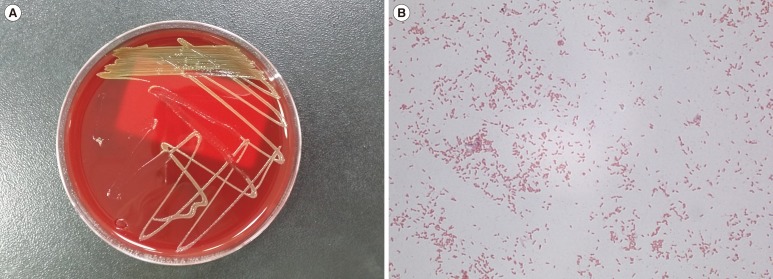Ann Lab Med.
2015 May;35(3):384-386. 10.3343/alm.2015.35.3.384.
Flavobacterium ceti From Blood Samples of a Korean Patient With Alcoholic Liver Cirrhosis
- Affiliations
-
- 1Department of Laboratory Medicine, Seoul National University Hospital, Seoul, Korea.
- 2Department of Laboratory Medicine, Seoul National University College of Medicine, Seoul, Korea. jeannie@snu.ac.kr
- 3Department of Laboratory Medicine, Seoul Metropolitan Government-Seoul National University Boramae Hospital, Seoul, Korea.
- KMID: 2363218
- DOI: http://doi.org/10.3343/alm.2015.35.3.384
Abstract
- No abstract available.
MeSH Terms
Figure
Reference
-
1. Bernardet JF, Bowman JP. The genus Flavobacterium. In : Dworkin M, Falkow S, Rosenberg E, Schleifer KH, Stackebrandt E, editors. The prokaryotes: a handbook on the biology of bacteria. 3rd ed. New York: Springer;2006. p. 455–480.2. Vela AI, Fernandez A, Sánchez-Porro C, Sierra E, Mendez M, Arbelo M, et al. Flavobacterium ceti sp. nov., isolated from beaked whales (Ziphius cavirostris). Int J Syst Evol Microbiol. 2007; 57:2604–2608. PMID: 17978226.
Article3. Laffineur K, Janssens M, Charlier J, Avesani V, Wauters G, Delmée M. Biochemical and susceptibility tests useful for identification of nonfermenting gram-negative rods. J Clin Microbiol. 2002; 40:1085–1087. PMID: 11880447.
Article4. CLSI. Interpretive criteria for identification of bacteria and fungi by DNA target sequencing; Approved guideline, MM18-A. Wayne, PA: Clinical and Laboratory Standard Institute;2008.5. Hsueh PR, Hsiue TR, Wu JJ, Teng LJ, Ho SW, Hsieh WC, et al. Flavobacterium indologenes bacteremia: clinical and microbiological characteristics. Clin Infect Dis. 1996; 23:550–555. PMID: 8879779.
Article6. Crum-Cianflone NF, Matson RW, Ballon-Landa G. Fatal case of necrotizing fasciitis due to Myroides odoratus. Infection. 2014; 42:931–935. PMID: 24806817.
Article7. Tian GZ, Piao DR, Zhao HY, Jiang H, Cui BY, Li JY. A Flavobacterium lindanitolerans strain isolated from the ascites sample of a Chinese patient with EV71 virus infection. Biomed Environ Sci. 2011; 24:694–696. PMID: 22365408.
- Full Text Links
- Actions
-
Cited
- CITED
-
- Close
- Share
- Similar articles
-
- Comparison of bacterial infection rate between patients with alcoholic liver cirrhosis and viral liver cirrhosis
- The Cause and Complication of Liver Cirrhosis during the Reccent 5 Years
- Three Cases of Spontaneous Muscle Hematoma in Alcoholic Liver Cirrhosis
- Massive bleeding from a rectal Dieulafoy lesion in a patient with alcoholic cirrhosis
- Henoch–Schönlein purpura nephritis and colitis in an adult patient with alcoholic liver cirrhosis


